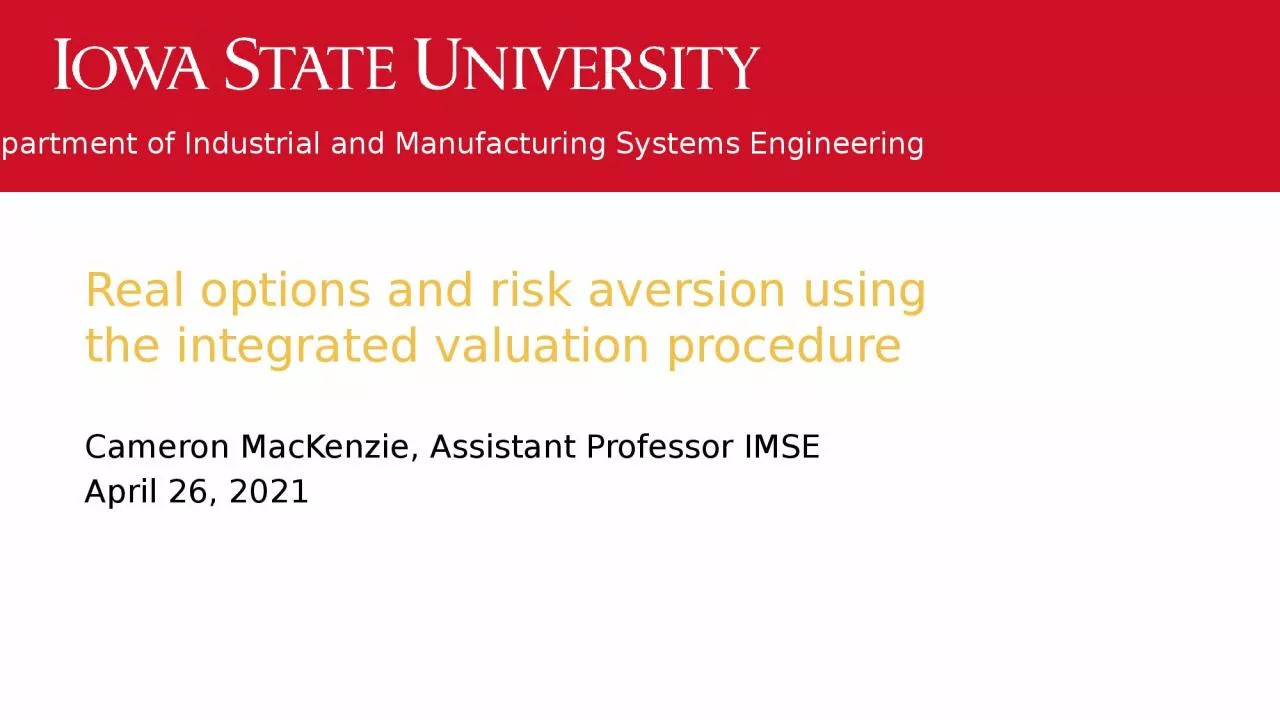

Cameron MacKenzie Assistant Professor IMSE April 26 2021 Public or market risks Based on option theory in financing Assumption that all risk can be mitigated by hedging Use riskfree interest rate ID: 1028311
Download Presentation The PPT/PDF document "Real options and risk aversion using the..." is the property of its rightful owner. Permission is granted to download and print the materials on this web site for personal, non-commercial use only, and to display it on your personal computer provided you do not modify the materials and that you retain all copyright notices contained in the materials. By downloading content from our website, you accept the terms of this agreement.
1. Real options and risk aversion using the integrated valuation procedureCameron MacKenzie, Assistant Professor IMSEApril 26, 2021
2. Public or market risksBased on option theory in financingAssumption that all risk can be mitigated by hedgingUse risk-free interest rate Under these assumptions, any decision maker (risk neutral, risk averse, risk seeking) would have the same value for a real option2
3. Can all risk be hedged in the market?Integrated valuation procedure (Smith and Nau 1995, Smith and McCardle 1998)If a risk is a market or public risk (i.e., can be perfectly hedged in the market) use risk-neutral probabilities and risk-free rate to calculate value of optionsIf a risk is a private risk that cannot be hedged in the market, use subjective probabilities andRisk-free rate and expected NPV if decision maker is risk neutralRisk-averse utility function if decision maker is risk averse 3Smith, J. E. & Nau, R. F. (1995). Valuing risky projects: Option pricing theory and decision analysis. Management Science 41(5): 795-816.Smith, J. E. & McCardle, K. F. (1998). Valuing oil properties: Integrating option pricing and decision analysis approaches. Operations Research 46(2): 198-217.
4. 3-bus example over two years (from Nur, 2021)4Load at bus 1LMP at bus 1LMP at bus 2LMP at bus 3Without generator at bus 1Year 1270$8.045$7.85$7.97148$7.85$7.85$7.85Year 2365$8.045$7.85$7.97200$7.85$7.85$7.85110$7.85$7.85$7.85With generator at bus 1Year 1270$7.92$7.85$7.893148$7.85$7.85$7.85Year 2365$7.92$7.85$7.893200$7.85$7.85$7.85110$7.85$7.85$7.85Nur, G. N. (2021). Evaluation of license for two years. Working presentation, Iowa State University, April 19.
5. Decision model (uncertainty in load, investment cost, and operations and maintenance)5Purchase generator for year 1Load at bus 1 in year 1 Investment costTotal costPurchase generator for year 2 if no purchase for year 1Load at bus 1 in year 2 O&M cost
6. Decision tree6Load = 270Load = 148Purchase generator for year 1Don’t purchase generator for year 1Load = 270Load = 148High investment costLow investment costPurchase generator for year 2Don’t purchase generator for year 2High O&M costLow O&M costLoad = 365Load = 110Low investment costLoad = 200Load = 365Load = 110Load = 200High investment cost
7. Key assumptionsHorizon timeline: 2 yearsRisk aversion modeled by an exponential utility functionLoadLoad in year 2 depends on load in year 1 (probabilistically dependent)Risk of load uncertainty (higher LMPs) can be perfectly hedged in the electricity market risk attitude is irrelevantInvestment and O&M costsCosts are annualizedO&M cost begins in year after investment cost (i.e., no O&M cost if generator purchased for year 2)Risk of investment and O&M costs cannot be hedged risk attitude is incorporated7
8. ParametersAnnual discount rate = 5%Generator’s lifetime = 30 years (used to annualize investment cost)8ValueProbability of highLowProbability of lowLoadup0.51down0.49Investment cost (over 30 years)$3M0.60$1M0.40Annualized investment cost$195,000$65,000O&M cost$400,0000.70$200,0000.30Risk neutralModerate risk aversionVery risk averseInterpretation: Indifferent between $0 for certain and …… 50% chance of $1M profit and 50% chance of $1M loss… 52% chance of $1M profit and 48% chance of $1M loss… 99% chance of $1M profit and 1% chance of $1M lossRisk toleranceInfinity$10M$200,000
9. Results9Risk neutralModerate risk aversionVery risk averseYear 1 decisionPurchase generator$111,406,681$111,407,210$111,430,402Don’t purchase generator $111,025,161$111,025,246$111,029,188If generator is not purchased for year 1 and …… load = 270 in year 1Purchase generator for year 2… load = 148 in year 1Don’t purchase generator for year 2If no generator is available$111,068,328$111,068,328$111,068,328Value of option to purchase generator$43,167$43,082$39,140Certain equivalent of discounted costExpected discounted cost
10. Sensitivity of option value to investment cost10
11. Value of option (moderately risk averse)11Low investment cost and low O&M cost is set to $0Probability of high investment cost = 0.6Probability of high O&M cost = 0.7
12. Difference in value of option between risk neutral and moderately risk averse12
13. Difference in value of option between risk neutral and very risk averse13
14. Time to purchase generator (moderately risk averse)14Purchase generator for year 1Purchase generator for year 2 if load = 270 in year 1Never purchase generator
15. ConclusionsValue of option (purchasing a generator) is relatively small compared to cost of generation for all risk attitudesCost of generation = $111M and maximum value of option = $300,000The additional generator decreases the LMP by approximately $0.13Difference between risk neutral and risk averseUncertainty in investment and O&M costs decreases the generator’s value to risk-averse decision makerMaximum difference in value$800 between risk neutral and moderately risk averse$22,000 between risk neutral and very risk averseAssumption: risk of increased load (larger cost of generation) can be perfectly hedged how would results change if only some or none of that risk could be hedged?15High investment cost makes value worthless for any type of risk attitude